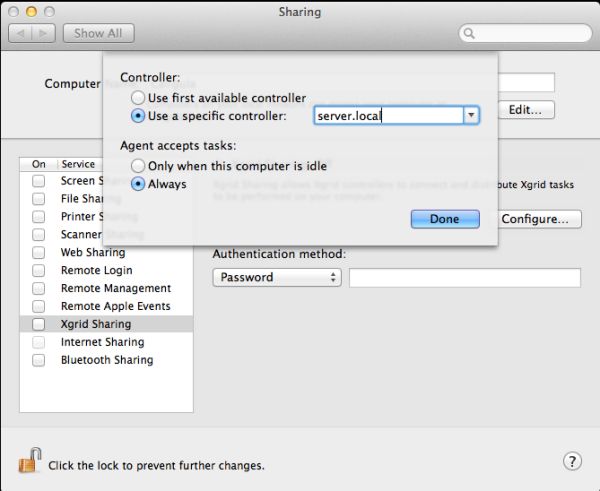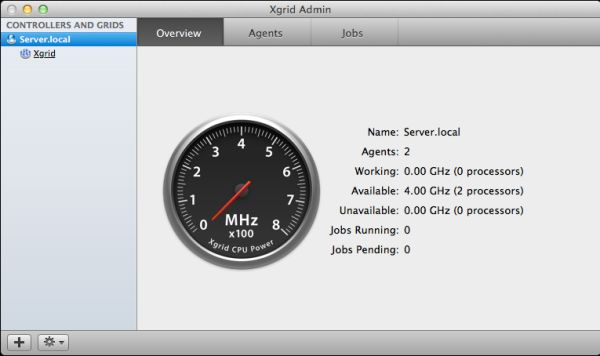In-Depth with Mac OS X Lion Server
by Andrew Cunningham on August 2, 2011 8:00 AM ESTXgrid is the last of the services we'll be looking at tonight, and it's not a new one so we won't spend too much time here. Accessible only via Server Admin, Xgrid is Apple's distributed computing service - basically, it allows many computers to process a single task, thus completing that task exponentially more quickly than any one computer could do alone.
Configuring the service is easy - just select the service in Server Admin, click the Configure Xgrid Service button, elect to create an Xgrid Host, input your Directory Administrator credentials, and you're done.
You can control how clients authenticate to your Xgrid in the Controller tab within the Settings tab. For convenience's sake, I'll just have my clients authenticate with a simple password. By the same token, you can make your server's CPU cycles available to Xgrid in the Agent tab.
Now, to get other computers in on the fun, go to the Sharing System Preference pane, go to Xgrid Sharing, and click Configure. Tell your computer to use a specific controller, and input your server name.
Under Authentication method, make sure what you put here matches the setting you put in on the server, and then check the service's checkbox to start it up.
Now, check to see that everything is working using the Xgrid Admin Server Admin Tool - if you've configured your computers correctly, you should see that a pool of CPUs are available for your use.
Your Xgrid clients can now submit jobs via the command line, and you can use Xgrid Server to start, stop, pause, and dictate the priority of those jobs.
The actual use of Xgrid is a little outside the scope of this review, but sadly it's one of those things that sounds a lot cooler in theory than it is in practice. You can't really use Xgrid to speed up consumer applications from Apple or Adobe - it's best used to help with CPU-intensive calculations, and it's not even ideal for all of those. If you're interested in learning more (and if you're fairly technically literate), I'll point you toward the generally excellent Xgrid wiki and wish you luck.














77 Comments
View All Comments
the_engineer - Thursday, August 4, 2011 - link
Indeed, and that's the plan, assuming nothing else I like more comes along. I was really sort of tantalized by the possibility of software RAID in OSX, and still haven't been able to get a straight answer on it. Currently it is looking like it's a no go.tff - Tuesday, August 2, 2011 - link
As a home user, I've been frustrated by the inability to have two users edit a shared calendar in OS X/iOS without using 3rd party software.How would it differ using Lion server to accomplish this rather than Lion and iOS 5 clients using iCloud?
Typical Mac home user- iPhones, iPads, Mac laptops.
Omegabet - Tuesday, August 2, 2011 - link
You can install server.app on a client. Just copy the app over from the server. The first time you launch it, choose connect to a server. It will then run server.app from your client. Otherwise it will upgrade lion to the server version. This was recommended in the apple documentation (can't remember where though).qiankun - Tuesday, August 2, 2011 - link
One instance I found frustrating is that non-HSF+ volumes like NTFS and exFat cannot be accessed from other computers using SMB or AFP. You can add the volume to the file sharing list, pick whatever protocol you like, but when you try to access it you'll get an error. Same thing applies to the bootcamp partition.I like to use NTFS or exFat on external drives, for simple fact that whenever needed you can simply disconnect them from the mac server and plug into a PC. I know there are software that allows reading HSF+ partitions on windows, but it's not installed everywhere, very unlikely if you want to use the drive on a random computer you or your friend uses.
damianrobertjones - Tuesday, August 2, 2011 - link
Windows Home Server. That's all I have to add.justinf79 - Friday, August 5, 2011 - link
WHS isn't even in the same league...rs2 - Tuesday, August 2, 2011 - link
I've used a number of different wiki solutions, and the one included on OS X Server is a toy compared to most other popular wikis. There's just no comparison between the OS X wiki and something like Confluence or MediaWiki.gamoniac - Tuesday, August 2, 2011 - link
At first glance, this looks impressive, given the price tag and the myriad of features provided. However, the author should note the huge maintenance costs of this at best rudimentary product. Anyone who has used Apache or IIS 7 knows the Lion web server is years away from catching up.What good is a cheap product if you have to to spend, say, 40 hours, trying to get something to work. The TCO is too high even at $10/hour, and even for home users.
gamoniac - Tuesday, August 2, 2011 - link
PS: Good article nonetheless. Thank you AT. Keep them coming!repoman27 - Wednesday, August 3, 2011 - link
What's good about a cheap product with a myriad of features is that if even one or two work as advertised out of the box, it was worth it. If not, you're only out $50. I configured Snow Leopard Client on a MacBook Pro to work as a NetBoot / NetRestore server because I happened to find that functionality useful, and although it was trivial to do so, I'm perfectly inclined to shell out the $50 for Lion Server going forward rather than monkey around with another client version.In general, you're right though, it's stupid to cheap out on a capital expenditure and then spend an order of magnitude more trying to get someone who knows what they're doing to make it work.
Really, though, who doesn't spend at least 40 hours setting up a new server for the first time?